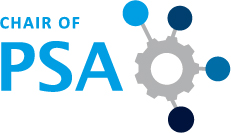Scientific news ticker august 2016
Competence in Mobility III - Modular production systems for electric vehicles
August 2016 The use of electric drive trains in future automotive applications leads to a completely new approach to the functional assemblies by systematically rethinking the overall system architecture of the automobile. The combustion-engine drive train was an essential component for the decades-long development of the current automotive system architecture and the resulting production systems. A clear trend of the modularization of assemblies can already be seen here and will be consistently developed further. The implementation of electrical drive trains creates new design possibilities for the construction of the overall system architecture of the automobile, but also new challenges in the product creation process. The increased implementation of module assemblies by system suppliers (battery module, drive module, etc.) leads to a further reduction of the in-house production rate. The planning and mastery of the production and assembly systems, and thus the elaboration of unique characteristics as the remaining core competence in the product development process, is inevitably the focus of economic considerations. The assurance of highly flexible and customer-specific assembly sequences with the aid of previously used layout methods in the production system encounters more and more functional limits, which must be discussed and overcome. In May 2016 the work on the collaborative project „Competence in Mobility“ (CoMo) III started. The IAF is responsible for the subproject vehicle as a complete vehicle and plays a leading role in the design and realization of the electrically driven automotive functional models (functional patterns) to be explored. The IAF's objective is to analyse, design and organize production systems of highly modularized electric vehicles. The work is carried out within the interdisciplinary research group for electro mobility "Editha". In the Como III pre-project "Editha 3.0", a functional model was developed as an experimental platform for researching the electrical drive by means of wheel hub motors. The implementation of Editha 3.0 was carried out under rigorous coordination from a constructive and manufacturing perspective. Based on the competences of already implemented electric vehicle functional models, the development goal was the stringent development and implementation of scalable Plug & Play Modular Solutions for the assemblies of the electric drive train.
Implementation and objective of the research project CoMo III
In order to verify the effects on the production and assembly systems as well as to determine the functional limits of previously used layout methods, the research activities were derived from the results of elektromobilen research projects (Elektroauto Editha 1.0, COMOI + II, ELISA - Modular Lightweight Components for Peripheral E-mobility System Solutions, Construction of a function carrier for wheel hub drives "Editha 3.0") and systematically completed by the findings gained during the implementation of a further real automotive functional model within CoMo III. The goal of the Editha team is to follow the development approaches of the Purpose Design and thus also to assess and evaluate the future automotive system architecture.
Instead of conversion to an electric drive in which the system architecture of the electric drive train (components, assembly and layout) is adapted to the vehicle architecture, the Purpose Design prioritizes the system architecture of the electric drive train and adapts the vehicle architecture or assumes the best possible vehicle concept. This allows the Editha team to develop with less constructive restrictions, whereby the research objective of modular, scalable Plug & Play modules can be stringently pursued.
The Editha team is striving to implement the automotive functional model in the CoMo III - Project with a high level of in-house production. Based on the competencies to design and assembly the electric drive train and its components, the implementation of the functional model is carried out with a focus on the aspects of safety, suitability for everyday life and sustainability. In this process, the extent to which core competencies for future automotive e-mobility projects can be realized and how these are supported by organizational models and strategies in the production system are to be crystallized. The results from the research activities provide a basis for the organization and structuring of e-mobile production systems and give the product a unique celling point.
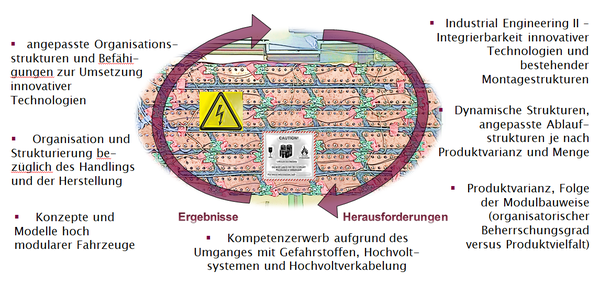 Picture1: Challenges and results of e-mobile production systems
Picture1: Challenges and results of e-mobile production systems
Pre-project "Editha 3.0"
The objective of the pre-project "Editha 3.0" was to design and technically implement an electrified vehicle, which is driven by wheel hub motors and has a licensed for use on public roads, on the basis of existing vehicle concepts. In order to limit the development risk of the project, the IAF decided to focus on the vehicle concept of a Smart 450 in the first functional model for a wheel hub motor. In doing so, it was possible to build on existing competences and to develop them in the direction of the modularity of the components. Important criteria within the conception were as follows: the unique distinctive feature of the complete vehicle, the use of standard components, realization of Plug & Play solutions, low costs and a low weight of the electric drive train. In particular, the HV battery module should have the highest possible capacity taking into account the criteria: simple and "AuS" -compliant assembly, quick and easy interchangeability of individual battery cells as well as fulfillment of the electrical parameters under the given installation space.
The early integration of DEKRA-Association into the project "Editha 3.0" made it possible to define the boundary conditions and general conditions according to the paragraphs of the road traffic regulations and to create the overall concept for the use of wheel hub motors. In particular, the design interventions and changes on the chassis were to be coordinated.
After a completed data analysis of the vehicle-specific systems, the combustion engine components were dismantled and the conversion started by the integration of the components of the electric drive and the adaptation of the cable harness.
The functionality of the implemented components of the electric drive was tested on the one hand on its own during the integration, on the other hand in conjunction with the vehicle control system developed by the IAF. Doing this, a step-by-step plan was pursued in which first the commissioning of the low-voltage system was carried out, then the electrical safety of the high-voltage system was to be checked and subsequently put into operation. The following work on Editha 3.0 deals with the fine programming of the vehicle control system so that both the driving mode as well as the interaction of the electric drive and the vehicle-specific control systems is made possible.
By consistently applying a modular structure during the conversion, the core points for the design and production-related implementation could be extracted. Components and assemblies were identified which reflect the further research potential for a component development. Especially in the IAF-focused concept of decentralized drivetrain architecture, the energy in the vehicle must be provided decentrally. For a modular structure of electric vehicles, the HV plug-in connection systems and the HV power distribution are then essential. The market offers a few scalable standard components, or they are still in conceptual stage, so that conceptually and constructively suitable solutions were developed by the Editha team itself.
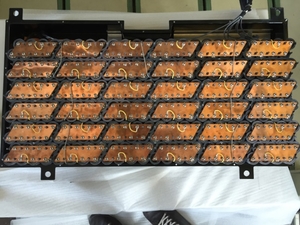 Picture 2: Lower battery module opened
Picture 2: Lower battery module opened
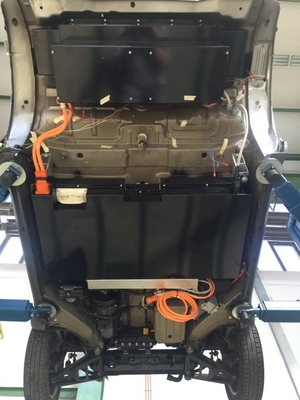 Picture 3: Fitted battery modules
Picture 3: Fitted battery modules
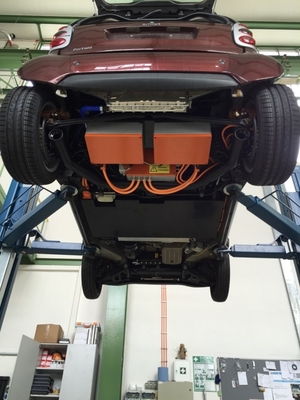 Picture 4: Mechanical fitting of the drive components
Picture 4: Mechanical fitting of the drive components
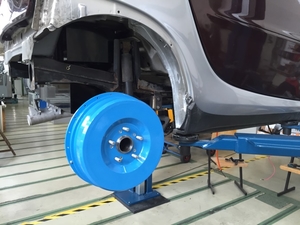 Picture 5: Finished mechanical functional pattern
Picture 5: Finished mechanical functional pattern
Further work
The results of the work within the framework of the pre-project "Editha 3.0" are incorporated into the concept of the following automotive functional model within the CoMo III joint project. The basic system architecture of "Editha 3.0" and the overview of the available components can be transferred by an adaptation to other vehicle concepts. Various variants are currently under discussion, including the implementation of a twin-drive logistics vehicle.
Contact: Dipl.-Ing. Gerd Wagenhaus (Leitung) / Dipl.-Wirtsch.-Ing. Stefan Lüdecke
ComoIII "COmpetence in MObility" is supported by:
![]()

